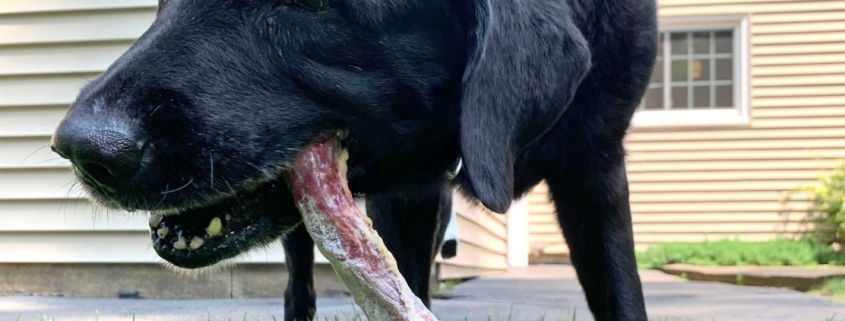Is it Safe to Feed Your Dog a Raw Meaty Bone?
The topic of feeding meaty bones tends to drum up some controversy. Is it safe to feed your pet a raw meaty bone? Is it even beneficial to your pet? How do you know which bones are safe to feed? Let’s address some of these questions.
Raw meaty bones (RMBs) are safe to feed as long as they meet certain safety parameters:
- Meaty bones should be purchased from a reliable source with safe handling practices in place and that regularly tests their products for harmful pathogens. Use only RMBs sold specifically for pet consumption. In the U.S., a zero-tolerance policy for raw pet food products ensures that the product has not tested positive for pathogens such as E. Coli or Salmonella. In other words, you should not give your pets RMBs from a grocery store.
- Choose the appropriate size/type of bone for your pet. Small RMB’s like chicken necks are perfect for small dogs and cats, whereas turkey and duck necks are better suited for medium to large dogs. As a general rule, it is appropriate to feed a bone the size of your dog’s head. Most dogs, when fed an appropriate size bone, will chew the bone well before swallowing. However, if your dog is a “gulper” or is likely to try and swallow large things without chewing, a RMB may not be an ideal choice for your dog. If you have questions, our staff can help you decide which bones may be appropriate for your dog.
- As with all toys and chews, always monitor your dog when feeding bones. Although dogs usually know what to do with a bone, it is important to ensure they are not going to swallow it whole.
Frequently Asked Questions (FAQ’S)
I give my dog marrow bones. Is that the same thing?
No. Marrow bones are known as ‘recreational bones’ because your pet should not be able to chew and consume the bone itself, but rather the tiny bits of fat, tissue, and cartilage left on the bone, as well as the inner bone marrow. ‘Raw meaty bones’ generally refer to bones that have more ‘meat’ on them and less bone, such as turkey and duck necks.
Do they eat the whole thing, bone and all?
Yes. Since RMBs are mostly thin bone, tissue, and cartilage, they are easy for your pet to break up, chew and swallow.
Do I let it thaw?
No. It is not necessary to thaw your raw bones before feeding. However, some dogs and most cats prefer to have their bone thawed to soften the frozen tissue prior to feeding. If you must thaw the bone, leave it in the fridge for a couple of hours, or submerge it in cool water inside a plastic baggie to thaw it faster.
Should I cook it?
No. Never feed a cooked bone. Cooked bones can splinter, which can cause intestinal obstructions and perforations (not good!).
Which types of bones are safe to feed?
Do not feed weight-bearing bones of heavy animals. What does this mean? When you think of a large animal such as a cow, weight-bearing bones are those that allow the animal to stand properly, which can be too hard on your dog’s teeth.
Why should I offer my dog raw meaty bones?
Bones are an excellent addition to our pet’s diet, and here’s why:
- They’re an excellent source of calcium, phosphorus, and glucosamine.
- They can help with firmer stool.
- They can help maintain cleaner teeth and better oral health.
- They offer mental and physical enrichment for an overall happier (and less bored) pet.
How often should I feed my dog raw meaty bones?
Bones should be fed intermittently as a compliment to your pet’s regular diet. Feeding frequency will depend on your pet’s size, age, and activity level. While they can occasionally be fed in place of a meal, they should not be fed every day.






